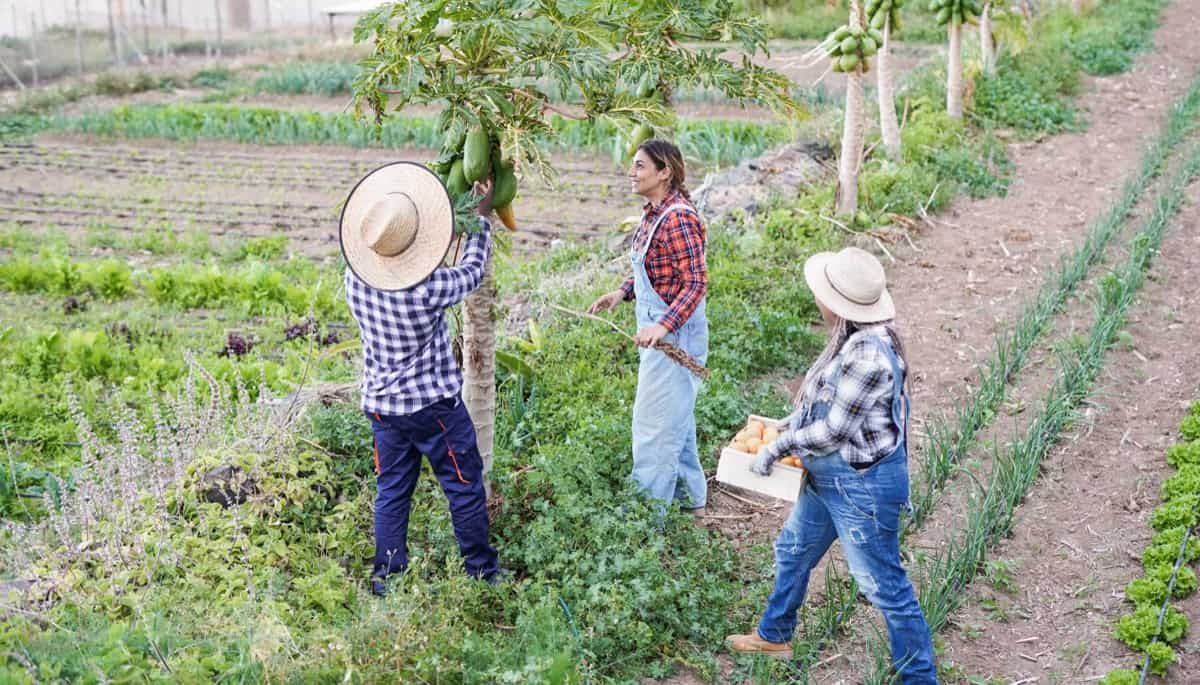Cooperative Societies play a pivotal role in the vast expanse of India’s agriculture. These entities are like pillars, supporting the aspirations of countless farmers nationwide. But what exactly are they? Agricultural Cooperative Societies are associations formed by farmers for farmers.

They join hands to pool resources, knowledge, and strength. This unity empowers them in truly transformative ways. Through this blog, we’ll embark on a journey to understand the significance of these cooperatives. We’ll explore how they enhance productivity, provide financial stability, and foster sustainability in farming. We’ll also delve into their challenges and the legal framework governing them.
Cooperative Societies in the Agricultural Sector in India
What are Cooperative Societies?
Cooperative Societies are like teamwork champions in farming. Imagine a group of farmers, like friends in a team, coming together to help each other. They pool resources like money, tools, and knowledge to grow crops better. This way, they can buy things in bulk and get better prices for their crops.
Cooperative Societies also provide loans to farmers when they need money for seeds or equipment. It’s like a big support system for farmers, making farming easier and more profitable. So, Cooperative Societies are like farming clubs where farmers team up to succeed.
The Role of Cooperative Societies in Empowering Indian Farmers
- Collective Strength: Cooperative Societies are like farmer communities where they join forces. Together, they become stronger and can tackle challenges effectively.
- Bulk Buying Power: These societies enable farmers to buy bulk seeds, fertilizers, and equipment. This lowers individual costs, ensuring affordability.
- Fairer Prices: When farmers sell their produce collectively, they can negotiate better prices in the market, increasing their income.
- Access to Credit: Cooperative Societies provide financial support, offering loans to farmers when they need capital for farming activities.
- Knowledge Sharing: Farmers exchange ideas and knowledge within these societies, learning new and improved farming techniques.
- Risk Mitigation: Sharing risks is easier in cooperatives. If one farmer faces a loss, others can help and support them.
- Market Linkages: These societies often connect with markets, ensuring a steady demand for farmers’ products.
- Government Support: Many government schemes and subsidies are channeled through these societies, benefiting farmers.
- Legal Protection: Cooperative Societies are protected by laws, ensuring transparency and fair practices.
- Empowering Women: They also empower women in rural areas by allowing them to participate in farming and decision-making.
In case you missed it: The Sustainable Solution: Bio-composting with Agricultural By-products

Understanding Agricultural Cooperatives: A Boon for Rural India
Agricultural cooperatives are a vital resource for rural India, providing farmers with shared resources like money and equipment, enabling them to afford better things together. They also negotiate better prices when selling crops, providing loans when needed for seeds or tools. Farmers in cooperatives learn from each other, strengthening each other in times of trouble. They also find markets for farmers, eliminating the worry of selling their crops. The government often supports cooperatives with benefits and schemes, making them a valuable tool for rural India.
Different kinds of Cooperative Societies in Indian Agriculture
Short-Term Cooperative Credit Structure (STCCS)
- STCCS mainly deals with short-term financial support for farmers and rural artisans. It has three key components:
- Primary Agricultural Credit Societies (PACS): These are found at the village level and are the foundation. They provide crop loans and working capital to local farmers.
- Central Cooperative Banks (CCBs) operate at an intermediate level, connecting PACS with higher-level institutions. They facilitate the flow of credit.
- State Cooperative Bank (StCB): StCBs coordinate and manage the overall credit structure at the apex level. They support PACS and CCBs in serving farmers’ financial needs.
Long Term Cooperative Credit Structure (LTCCS)
- LTCCS focuses on medium and long-term loans to support agricultural investments and rural industries. It includes:
- State Cooperative Agriculture and Rural Development Bank: These banks operate at the state level, providing medium to long-term loans for agricultural development and rural industries.
- Primary Cooperative Agriculture and Rural Development Bank: These are branches of SCARDB, found at the district or block level, ensuring local accessibility to these long-term loans.
In case you missed it: Crop Residue Management: A Sustainable Approach for Agricultural Success

Large Area Multi-Purpose Societies (LAMPS) and Farmers Services Societies (FSS)
These cooperative institutions serve specific populations like tribals, farmers, and rural communities. They cater to various needs and services tailored to the local context. As of 2022, there are a significant number of cooperative societies working in the agriculture sector, including 1,00,428 Primary Agricultural Credit Societies/ Large Area Multi-Purpose Societies/Farmers Services Societies and 619 State Cooperative Agriculture and Rural Development Banks and Cooperative Agriculture and Rural Development Banks.
Ministry of Cooperation’s Role in Promoting Cooperative Societies
The Ministry of Cooperation was established in July 2021, focusing on cooperation and cooperative businesses, formerly under the Ministry of Agriculture, Cooperation, and Farmers Welfare.
- The Ministry is led by the Hon’ble Minister for Cooperation and supported by the Hon’ble Minister of State for Cooperation.
- Administrative oversight comes from the Secretary, Cooperation, an Additional Secretary, two Joint Secretaries, and a Central Registrar of Cooperative Societies.
- The Ministry is dedicated to creating a distinct legal, administrative, and policy framework to strengthen the cooperative movement in India.
- Its mission is to deepen the cooperative movement, ensuring it reaches every corner of the country, especially rural areas.
- It aims to develop a cooperative-based economic model where members work with a sense of responsibility.
- Simplifying business processes for cooperatives, making it easier to operate.
- Facilitating the development of Multi-State Cooperative Societies.
- Prioritizing transparency, modernization, and computerization within cooperatives.
- Focusing on improving accessibility to development in rural areas, especially for the underprivileged.
- Aspiring to connect every village with cooperatives, aiming for prosperity through cooperation.
Initiatives to Promote Cooperatives in the Agricultural Sector in India
- National Cooperation Policy: A new policy is being developed to promote cooperative-based economic development, strengthen the cooperative movement, and reach rural communities.
- Computerization of PACS: A project to computerize Primary Agricultural Credit Societies (PACS) will improve transparency and efficiency in financial services, benefiting small and marginal farmers.
- Model Byelaws for PACS: Model bylaws have been created to allow PACS to engage in various businesses, expanding their scope beyond traditional agriculture.
- PACS as Common Service Centres (CSC): PACS are being transformed into Common Service Centres to provide e-services in villages, boosting their viability and generating employment.
- National Cooperative Database: A database is being developed to provide accurate and updated information on cooperatives, aiding policy-making and implementation.
- Establishment of Multi-Purpose PACS, Dairy, and Fisheries Cooperatives: Plans are in place to set up new cooperatives in every Panchayat/Village, covering various sectors like dairy, fisheries, and more.
- Amendment of MSCS Act, 2002: Proposed amendments aim to enhance transparency, governance, and accountability in Multi-State Cooperative Societies.
- National Cooperative Development Corporation (NCDC): NCDC has launched new schemes to provide financial assistance to cooperatives in sectors like self-help groups, agriculture, dairy, and fisheries.
- Cooperatives on GeM Portal: Cooperatives can now register as buyers on the GeM portal, enabling them to procure goods and services efficiently.
- Tax Rebates for Cooperative Societies: – Various tax incentives, including reduced surcharge, lower Minimum Alternate Tax (MAT), and higher deposit and loan limits, have been introduced to support cooperatives.
- Relief to Sugar Cooperative Mills: – Sugar cooperatives have received relief measures, including the ability to claim expenditure on payments to sugarcane farmers.
- New National Multi-State Cooperative Societies: – Apex national cooperative societies are being established for seed production, organic products, and export promotion.
In case you missed it: Climate-Smart Agricultural Methods for More Yields and High Profits

Agricultural Cooperatives: Boosting Farmers’ Success
Empowering Farmers Through Cooperation: Farmers in cooperatives join forces to control supply and marketing channels, allowing them to buy input supplies at lower costs and sell their products in larger markets for better prices.
Enhancing Productivity and Sustainability: Agricultural cooperatives invest in modern equipment, boosting productivity and the quality of goods. This contributes to sustainable agriculture practices.
Rural Development Through Diverse Services: In rural areas, cooperatives are often the sole providers of goods, Commodity and services. They go beyond agriculture, offering services like electricity, telecommunications, fuel, and chemicals, benefiting the entire community.
Job Creation and Income Rise: Cooperatives provide employment opportunities, raise workers’ income, and contribute to increased food supplies and better services, enhancing the social security of residents.
Principles of Cooperation: Cooperatives operate based on self-help, voluntary membership, transparency, autonomy, and shared responsibilities, setting them apart from other organizations.
Cooperative Structure: Cooperatives come in various sizes, from local to regional and even global. Depending on member numbers and territory covered, they may operate under centralized, federated, or mixed structures.
Supply Cooperatives: These cooperatives focus on inputs needed for farming, such as seeds, fertilizers, and machinery parts. They help farmers save money by purchasing in bulk.
Marketing Cooperatives: Marketing co-ops assist farmers in selling their products, buying goods at favorable prices, and handling promotions and advertising.
Service Farming Cooperatives: These cooperatives provide various services to agriculture, including transportation, storage, legal support, equipment repair, and financial services like loans and deposits.
Challenges Faced by Agricultural Cooperatives: Challenges include rising expenses, limited marketing skills, conflicts among members, financial sustainability issues, labor shortages, and slow adoption of modern farming technologies.
10 Cooperative Societies in the Agricultural Sector in India
National Agricultural Cooperative Marketing Federation of India Ltd
- Work Area: NAFED operates nationwide, facilitating the marketing of agricultural produce.
- Objectives: It aims to ensure fair prices to farmers, eliminate intermediaries, and provide market access.
- Benefits to Farmers: NAFED helps farmers receive better crop prices by directly connecting them to markets and reducing post-harvest losses.
Indian Farmers Fertilizer Cooperative Limited (IFFCO)
- Work Area: IFFCO is engaged in the production and distribution of fertilizers.
- Objectives: It strives to make fertilizers accessible and affordable to farmers.
- Benefits to Farmers: IFFCO ensures a steady supply of quality fertilizers, enhancing soil fertility and crop yields for farmers.
National Dairy Development Board (NDDB)
- Work Area: NDDB focuses on the dairy sector, promoting milk production and processing.
- Objectives: It aims to empower dairy farmers, improve milk quality, and create a sustainable dairy industry.
- Benefits to Farmers: NDDB helps dairy farmers access markets, obtain fair milk prices, and gain training in modern dairy practices.
In case you missed it: List of Agricultural Sensing and Monitoring Devices

Small Farmers Agribusiness Consortium (SFAC)
- Work Area: SFAC supports agribusiness ventures for small and marginal farmers.
- Objectives: It seeks to enhance income and employment opportunities for these farmers.
- Benefits to Farmers: SFAC assists small farmers in diversifying their income sources and participating in value-added agricultural activities.
National Horticulture Board (NHB)
- Work Area: NHB promotes horticulture production and post-harvest management.
- Objectives: It aims to boost fruit and vegetable production, increasing farmers’ incomes.
- Benefits to Farmers: NHB provides technical support and funding to farmers, helping them grow high-value horticultural crops.
National Cooperative Development Corporation (NCDC)
- Work Area: NCDC offers financial assistance and support to various cooperative societies.
- Objectives: It aims to strengthen cooperatives in multiple sectors, including agriculture.
- Benefits to Farmers: NCDC provides funding and expertise to agricultural cooperatives, improving their efficiency and competitiveness.
Krishak Bharati Cooperative Limited (KRIBHCO)
- Work Area: KRIBHCO specializes in the production and distribution of fertilizers.
- Objectives: It strives to provide quality fertilizers to farmers at reasonable prices.
- Benefits to Farmers: KRIBHCO ensures a stable supply of fertilizers, supporting crop productivity for farmers.
National Federation of Fishers Cooperatives Ltd. (FISHCOPFED)
- Work Area: FISHCOPFED focuses on the fisheries sector, including fish production and marketing.
- Objectives: It aims to improve the livelihoods of fisherfolk and promote sustainable fishing practices.
- Benefits to Farmers: FISHCOPFED helps fisherfolk access markets, obtain fair prices for their catch, and adopt responsible fishing methods.
National Oilseeds and Vegetable Oils Development Board (NOVOD)
- Work Area: NOVOD works in the oilseeds and vegetable oils sector.
- Objectives: It aims to enhance oilseed production and reduce edible oil imports.
- Benefits to Farmers: NOVOD supports oilseed cultivation, reducing India’s dependency on edible oil imports and increasing farmers’ income.
National Federation of Farmers’ Procurement, Processing, and Retailing Cooperatives of India Ltd
- Work Area: NACOF procures, processes, and retails agricultural products.
- Objectives: It seeks to eliminate intermediaries, ensure fair prices to farmers, and promote value addition.
- Benefits to Farmers: NACOF connects farmers directly to markets, improving their income and providing access to processed agricultural products.
Challenges and Opportunities in the Growth of Agricultural Cooperatives
Agricultural cooperatives face challenges such as limited resources, management issues, market access, and awareness and education among farmers. They need help with financial constraints, lack access to modern technologies, and can lead to inefficiencies and conflicts.
In case you missed it: 2023 on the State of Economy and Impact on Agricultural Businesses

Opportunities include economies of scale, technology adoption, value addition, policy support, and sustainability. Cooperatives can pool resources, reduce input costs, enhance productivity and product quality, and add value to products through processing, packaging, and marketing. Government policies and incentives can also promote cooperative growth and address challenges.
Conclusion
In India’s agricultural sector, cooperative societies are vital for rural development, empowering farmers, enhancing their income, and fostering sustainable agriculture. These collaborative efforts improve individual farmers’ lives and contributing to the growth and prosperity of the nation’s agriculture.
- Varieties of Castor in India: Boost the Profit with High-yielding Hybrids of Castor
- Cooperative Societies in the Agricultural Sector in India: Benefits, Role, and Challenges
- 17 Gardening Mistakes to Avoid This Summer: For Vegetables, Flowers, Herbs, and Fruits
- Bahar Treatment in Pomegranate for High Quality and Yields: A Step-by-Step Guide to Implementation
- Mobile Veterinary Units in India: Implementation in States
- Moringa as Feed for Livestock: Moringa Fodder Crop Yield Per Acre
- National Beekeeping and Honey Mission (NBHM): Features, Schemes, and Benefits
- Management of Cutworms in Chilli: Prevention and Control With Organic, Chemical, Cultural Practices
- Best Fertilizer for Tinda: Organic, Natural, Homemade, NPK Ratio, When and How to Apply
- Whitefly Management in Cotton Crop: Symptoms, Control, and Best Insecticides for Cotton
- Best Fertilizer for Terrace Plants: Covering Vegetables, Fruits, Flowers, and Herbs
- 12 Best Compost Bins for Home in India with Price: Cheap for Indoors, Outdoors, and Kitchens
- Grapes Training Systems and Methods: A Comparative Analysis
- Best Fertilizer Jamun Tree: Organic, Natural, Homemade, Npk Ratio, When and How to Apply
- Polyhalite Fertilizers and their Role in Organic Farming
- How to Identify Fake Seeds: Key Differences Between Real and Counterfeit Seeds
- Best Fertilizer for Indian Gooseberry/Amla: Organic, Homemade, NPK Ratio, When and How to Apply
- Best Fertilizer for Bitter Gourd: Organic, Natural, Homemade, NPK Ratio, When and How to Apply
- Bangalore Method of Composting: Preparation Method, Benefits, and Disadvantages
- How to Check PM Kisan Status: Beneficiary Verification With Aadhaar Number and Mobile
- 15 Best Chaff Cutter Machines in India: For Dry, Green Fodder Cutting, and Price List Included
- Bermuda Grass Fertilizer Schedule: When and How to Apply in Winter, Summer, and Spring
- 20 Best Plants to Grow Under Oak Trees: Compatible Plants Under and Around Oaks
- Benefits of DAP Fertilizer: Price, Composition, How and When to Apply
- Profitable Thai Guava Farming in India: Yield, Profit Per Acre, Plant Price, 1 Acre Cost of Cultivation
- Top 19 Water Harvesting Techniques: What is Water Harvesting and Benefits of It
- Best 20 Lemon Varieties: Sweet, Large, and Rare High Yield Cultivars
- Top 15 Agro Based Industries in India: Best List for Agri Entrepreneurs
- Career Opportunities in Agribusiness Management: Top 10 Jobs After Agribusiness Management
- Top 20 Pumpkin Varieties to Grow in Your Garden: Best List of Pumpkin Varieties for High Profits
- How to Grow Cordyceps Mushrooms: Profitable Cultivation Practices and Cordyceps Mushroom Price
- Top 20 Lettuce Varieties to Grow in Your Garden: Best List for Backyard for Fall and Winter
- Top 20 Grape Varieties to Grow in India: List of Grape Varieties to Grow for High Profits
- Best Fruit Nurseries in Tamil Nadu: Top List of Saplings Supplier for High Yield and Profits
- Top 20 Apple Varieties in India: List of Apple Varieties to Grow for High Profits
- Advantages of Vegetative Propagation and Disadvantages of Vegetative Propagation: Examples
